This was published 5 years ago
Norway travel and cruising guide: The land of 1000 waterfalls has a secret
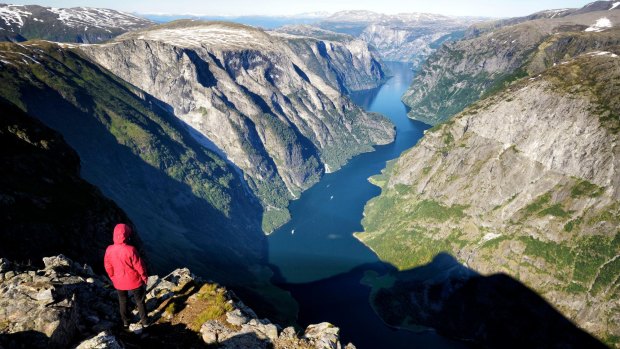
The view from the summit of Bakkanosi.Credit: Alamy
Norway, land of 1000 waterfalls and possibly the world's most successful society, has a secret. It's called friluftsliv, which sounds like a Nordic yoghurt but is, in fact, a complicated Scandinavian word for a simple, rather lovely concept.
It's an abiding passion for landscape, and an active appreciation of the country's incredible natural beauty.
This deep sense of calm spirituality – with a focus on balanced happiness and a common, inclusive ethos – goes some way towards explaining how Norwegians have used their oil riches since the 1960s. They've worked out that a happy society is a fair society, where the nation's bounty is shared equally.
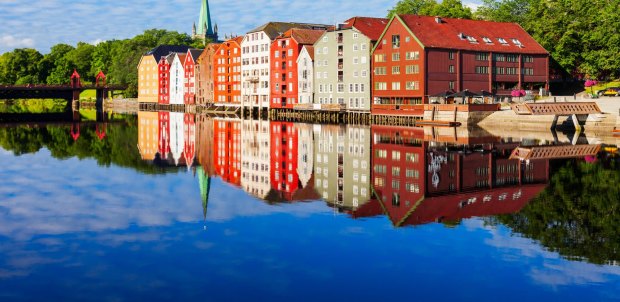
Colourful old houses at the Nidelva river embankment in the centre of Trondheim old town.Credit: Shutterstock
Their sovereign wealth fund, the world's largest, has more than $US1 trillion in assets. In May this year, in a country of 5.35 million, it was worth about $US195,000 ($271,000) for each Norwegian.
Their leaders haven't squandered the surplus revenue of the Norwegian petroleum sector or allowed it to flow into the hands of a few.
King Haakon VII, Norway's first, revered king after the dissolution of the union with Sweden in 1905, set a precedent. He wanted Norway to be a modest economy, spending wisely, carefully and honourably.
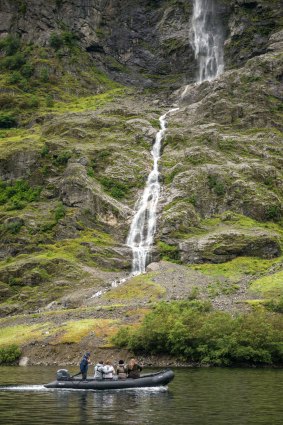
Cruising the fiords in a Zodiac.Credit: APT
Modern Norwegian leaders have taken note, investing prudently (and honourably) in Norwegians, current and future, by actively legislating policies to manage their long-term wealth, rather than taking a free-market approach, in which government disengages in favour of the market setting the pace and magnitude of development.
This determined economic focus on the common good, combined with a deep belief in friluftsliv – pronounced "free-loofts-liv" or "free air life", emphasising active health and spiritual happiness – has worked.
THE HAPPINESS FACTOR
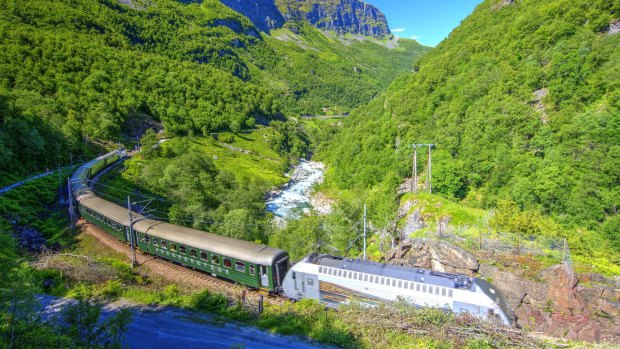
The Flam Railway climbs from sea level to the mountain station of Myrdal at 867 metres.Credit: Shutterstock
Year in, year out, among many other prosperity rankings, Norway finds itself at the zenith of the "happy countries" index, according to the United Nations' Sustainable Development Solutions Network.
Critically, from the friluftsliv perspective, rankings are based not just on per capita gross domestic product, but also life expectancy, which in Norway, according to the World Health Organisation, is 82.5, ranking it 10th in the world. Freedom, generosity, social support and absence of corruption in government and business are other markers that make for a happy country.
In an interview with Reuters this year Jeffrey Sachs, economics professor and director of the UN agency which produces the index, said happiness was a result of wealth and wellbeing. "Happy countries are the ones that have a healthy balance of prosperity and social capital, meaning a high degree of trust in a society, low inequality and confidence in government."
Norway, like its fellow Scandinavian social democracies, Sweden and Denmark, has not relied on trickle-down economics, a theory that claims tax breaks for business and the wealthy will stimulate investment and benefit all stratas of society in the long term.
Instead, motivated by citizens' wellbeing, they have mitigated and adapted the globalisation behemoth by investing in human capital. The Nordic social democracy model doesn't replace capitalism but promotes each Norwegian's economic security within the framework of capitalism.
Norway excels in aged care, in its care of the unemployed through compensation and retraining, in its care of young people, with intensive vocational education programs.
This investment is working. According to BBC Capital, Norwegian Millennials have enjoyed a 13 per cent rise in disposable income compared to Generation Xers when they were the same age, and are thus "bucking the downward trend in other strong Western economies".
AN ENLIGHTENED APPROACH
Norway, which is not part of the EU but is in NATO, has invested heavily in building highly skilled industries such as aquaculture, maritime industries, design and architecture, technology and telecommunications and hydro power. The development of these sectors is designed to sustain the country when the oil and gas supplies begin to dwindle.
Norwegians' sense of common good spawns a different cultural mindset to high taxation than that of some Western countries and they generally accept it funds their quality of life.
Norway was Europe's poorest country at the turn of the 19th century. Venturing outdoors in an often harsh environment to produce and catch food, as their forebears the Vikings did, was a necessity and developed a tough, resourceful people. When good times came, that outdoors lifestyle survived, finding its fulfilment in friluftsliv.
We have come to Norway to experience for a short time this dramatic land and its people, and their friluftsliv. We want to understand the modern Norway, forged from the resilient, far-ranging Viking to the hardy fishers and farmers to this wealthy nation, lucky in its oil finds but also sensible with its riches.
We're trying to do what they do – get out and be active, abetted by our 15-day APT Majestic Norwegian cruise on our small expedition ship, the MS Island Sky, whose spacious wood-panelled cabins and luxurious public areas provide an excellent counterpoint, it must be said.
We begin far north of the Arctic Circle in Tromso, glide down Norway's lacy shredded edge, and weave between channels and islands and into fiords, before glancing off Sweden and ending in Copenhagen.
The cruise mantra seems to be, if you are physically able (and there are calmer alternatives for those who are not), get out on to the fiords in Zodiacs and kayaks, hike into the mountains, up to the glaciers, on to bikes, get talking to Norwegians and experience this socially progressive country in all its visceral wonder.
Historian Kenneth Park assists with talks on diverse topics from Norway's art and architecture to Vikings and geography, and our excellent expedition crew includes a botanist and adventure specialists.
TROMSO AND THE ARCTIC CIRCLE
Friluftsliv finds a comfortable home in Tromso, 350 kilometres north of the Arctic Circle. The world's northernmost university town is nicknamed "Paris of the north" but it truly is the "gateway to the Arctic".
This is frontier country and a springboard to an icy wonderland as the jumping-off place for Arctic explorations. The town's Polar Museum features Roald Amundsen, Norwegian polar explorer and the first to reach the South Pole in 1911, and other intrepid explorers.
Tromso, with its pure air and historic wooden buildings, sits between fiords, mountain peaks and islands. Bathed in the balmy Gulf Stream, its mild temperatures defy the latitude, though less than an hour out of town, winter bites with temperatures scraping minus 25 degrees during the polar night.
It is also slap-bang in the middle of the northern lights oval, so the "green lady" aurora borealis dominates the sky from September to March, along with the midnight sun.
The city is proud of its nightlife and locally brewed beer but really, its heart is in the surrounding mountains and fiords – planning the next ski trip, hike, kayak run or hyttetur (trip to the cabin). There are about 300,000 getaway cabins in northern Norway, all designed with friluftsliv in mind.
Visit Tromso's 20 staff members all nominate an outdoor activity as their favourite activity with product co-ordinator Trude enunciating that Norwegian spirituality. "Silence is a wonderful kind of music. Go a little bit outside the city centre and just listen to the silence, take a deep breath and enjoy the fresh air," she says.
Hiking into those metamorphic-rock mountains will have to wait, but we enjoy the next best thing – dining on cuttlefish and lemon butter on Island Sky's Lido deck as our journey begins, watching the setting Arctic sun flooding the vivid landscape.
LOFOTEN ISLANDS
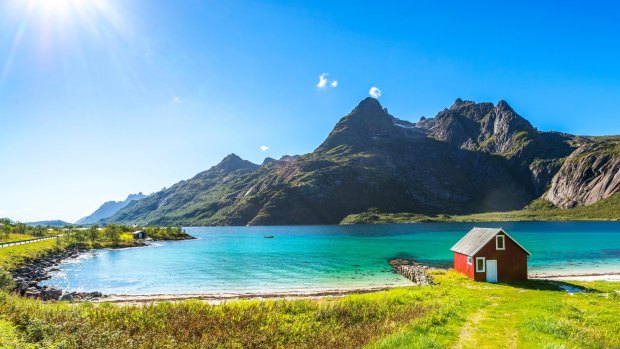
Credit: SHUTTERSTOCK
Hugging the coast with the Norwegian Sea to our right, we enter Raftsundet Strait, bordering the Lofoten Islands and, at crack of dawn, nose into a narrow gorge straight out of The Lord of the Rings – the two-kilometre Trollfiord.
Only 100 metres across at its entrance, it reinforces the wonder of small ship cruising. One can easily imagine otherworldly creatures inhabiting the 1100-metre high cliffs as white-tailed eagles circle. How we turn at the end is testament to the skill of our captain, Peter Lindstrom.
Viking sagas before 900AD tell tales of winter shoals of silver cod coming from the Barents Sea to spawn in the Lofoten Islands. These geographically striking islands have dominated the northeast Atlantic's cod fishing since then and the colourful wooden rorbus fishing shacks remain.
"Liquid sunshine", as our cruise director Emma Leslie calls rain, has joined our journey as we disembark at Lofoten's administrative centre Svolvaer for our exploration to the southwest point.
Towering over Svolvaer is the two-horned Svolvaergeita Mountain. Norwegians enjoy climbing it to spring across the 1.5-metre gap from one granite "goat horn" to the other. Some leap romantically across into one another's arms to seal their marriage vows. Not so much friluftsliv as just nuts.
Not even rain can smudge the beauty of this distinctive green and monumental landscape with its bays, white beaches, and traditional blood-coloured, yellow and white wooden houses. The Lofotr Viking Museum at Borg smashes some myths – "nei" to horned helmets, drinking out of horns and grubby, brown attire; "ja" to pink-and-blue clothes, make-up, dyed blond hair and excellent personal hygiene, even as they pillaged.
TORGHATTEN CLIMB
The Nordland Channel, which threads the broad belt of islands along western Norway, provides a kaleidoscope of visual beauty. Rich troves of legends surround the ice-forged "troll mountains" that pepper the sea and sprout on land.
We toast our Arctic Circle crossing with a champagne breakfast as the Arctic Circle monument on the islet of Vikingen slides modestly past.
We disembark at Bronnoysund, Helgeland coast's southernmost town, and head to Torghatten for our hole-in-the-hat hike. This mountain, called "nature's cathedral", is the subject of a legend involving trolls, seven maidens (there are always seven maidens), a hat turned to stone and an arrow.
There are three levels of hike but we choose "the full Monty", a five-kilometre, circular climb up a steep, uneven path and through the spectacular mountain hole, then down again through spring flower meadows. This is a great opportunity to get active on one of Norway's most striking mountains whose granite "hole", created by ice erosion, is 160 metres long, 35 metres high and 20 metres wide. Views to the water show why this mountain was a sailors' landmark.
This sojourn proves hiking is a happy way to experience the joys of Norway's crystal air, rich heathland, blueberry thickets and birch and ash woodland trees.
TRONDHEIM AND BRIKSDALSBREEN HIKE
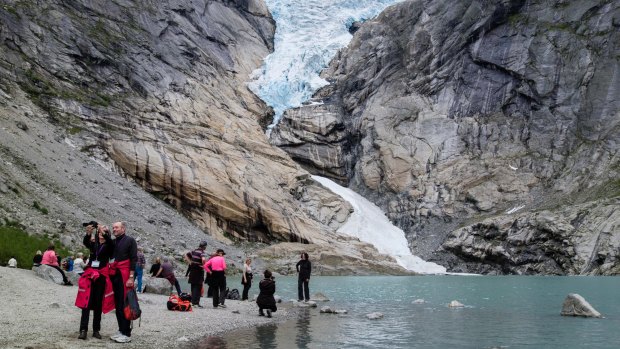
Credit: Alamy
Said Norwegian painter, Edvard Munch, "Nature is not only all that is visible to the eye, it also includes the inner pictures of the soul." He might have been referring to friluftsliv.
It's there in abundance as we walk around the nation's first capital, Trondheim, where the River Nidelva meets Trondheim fiord. It's about eight kilometres to the city from the ship, though there are easier options.
The Christian Viking King Olav Tryggvason founded this city in 997AD and its tranquillity proves that peace can also inhabit Norwegian cities, thanks to the abundant tree-lined streetscapes, squares and parks. Not far from the city, moose and deer inhabit the hills (and sometimes the city streets) and doubtless trolls and seven-maiden posses.
Nordfiord is the gateway to the glaciers and Island Sky is headed for the small village of Loen at fiord-end where we disembark by Zodiac for transfer to Briksdalbreen (breen means glacier). This glacier is a dramatic blue-green frozen tongue attached to Europe's largest glacier, Jostedal, which sits like a giant ice-bowl atop a vast glacial plateau.
Some choose to ascend to the glacier via "troll car" but we prefer to walk up the 2.5-kilometre path alongside the thundering Jostedalsbreen river to the glacier and its luminous lake. It's a drenching walk, both from the waterfall spray and bouts of Emma's "liquid sunshine", but illuminating to observe the marked path of the glacier, which is currently receding, and drink in the glacial air and forest aromas.
On a natural high we descend the mountain to tuck in to excellent coffee and cakes at the Briksdalen Mountain Inn.
WATERFALL COUNTRY AND FIORD HIKING
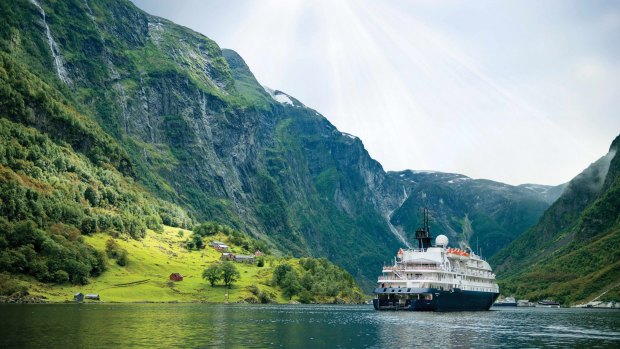
We head deep into Fosseheimen (waterfall country) in the heart of western Norway, between Bergen and Alesund. This is Sunnfjord, fed by three glacial rivers: Jolstra, Gaula and Nausta, which form more than 50 waterfalls.
At Likholefossen waterfall, we venture across a bridge and into the foothills, admiring plunging pillars of water at every turn. They feed the lakes and fiords that shelter the country's lean and delicious salmon.
At the high viewing point of Utsikten, we gain an appreciation of how glaciers have carved this wild landscape. We visit pretty churches and the Sunnfiord open-air Folk Museum where we gain an appreciation of the daily life of farmers in the 1800s.
Lunch is at the traditional farm-restaurant Eldalstunet in Viksdalen. The owners of this 16th-century farm still practise the Viking tradition of summer farming, where animals are driven high into the adjacent Gaularfjell Mountain to graze, preserving the lower fields for winter. Like the other Norwegians we meet, farm owners Marit and Henning display the characteristic serenity and self-assurance so evident in the culture. Despite an avalanche destroying the original farm in 1957, killing a family member, the family rebuilt 300 metres away and simply carried on.
King of the fiords, 203-kilometre Sognefiord, is Norway's longest fiord. Its narrowest branch, the steep-sided UNESCO-listed Naeroyfiord, with its hanging valleys, hamlets, waterfalls, sharp peaks and snowfields, is our destination. We sail down its 20 kilometres, where the narrowest section is only 250 metres, to Gudvangen at its head. This little village, meaning "God's place by the water", was an important Viking marketplace.
It's the Viking village for some while others hike about 10 kilometres along the fiord, deep among forest and wildflowers, past fiord ponies and cows, with the sun on our backs. It's tranquil and soul cleansing.
BERGEN AND BONDHUS LAKE HIKE
We disembark at another branch of the Sognefiord, Aurlandsfiord, for our journey on the Flam railway that climbs from sea level to the mountain station of Myrdal at 867 metres for waffles and coffee. Sadly, Flam is now inundated with tourists from giant cruise ships that nose incongruously into this "little place between steep mountains".
Norwegian composer Grieg's home of Bergen, with its colourful 16th-century wooden houses from the Hanseatic era, is our next port of call. It gives a group of us the opportunity to dine ashore on traditional Bergen and Hanseatic cuisine at Bryggen Tracteursted.
We choose Norwegian tapas which includes reindeer tartare, Aquavit marinated salmon, sardines, cured sausages and, smoked whale (Norway's hunting and consumption of whale is, in my opinion, its major weakness. I don't eat it). There's also breaded cod tongues, cheeks and cod "bottom".
Hardangerfiord delivers us to Rosendal and a brisk, six-kilometre hike up to Bondhus Lake and glacier. It's pouring, but our fit-as-a-fiddle guide Lilah is the epitome of Norwegian resilience. She and her friends swim regularly in the glacial lake, hike the heart-bursting climb to the glacier carrying cross-country skis and gear, camp overnight then ski down again.
Drenched, but full of the delights of friluftsliv, we hike back down and tuck in to coffee and traditional lefse (potato cake) and melkekake (sweet, raisin-filled egg bread) in Sunndal.
PULPIT ROCK CLIMB AND TELEMARK
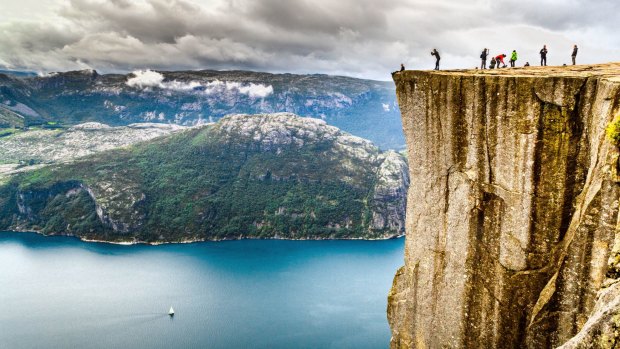
Pulpit Rock.Credit: Shutterstock
The Bondhus Lake hike is nothing to our Pulpit Rock slog. It's an incredibly satisfying steep climb up to the 604-metre rock the Norwegians call Preikestolen to gaze down at the Island Sky, tiny in the 42-kilometre Lysefiord (light fiord) below.
In places, the fiord is as deep as the surrounding 1100-metre mountains are high and our king-of-the-castle position means we can truly appreciate being wrapped in colossal, light coloured mountains, green valleys, snow-capped peaks and interspersed lakes. This is the highlight of the 8.5-kilometre round hike.
We dock in Norway's fourth largest city, Stavanger, which is Europe's oil and gas capital, and are driven the 25 kilometres to climb Norway's arguably most popular hike through jagged, dramatic terrain. Those who choose not to do it are offered alternatives including an illuminating visit to the Norwegian Petroleum Museum.
We carry packed lunches up through woodland, rocky steps, over narrow ledges, lake-stippled plateaux and gravel tracks to an unfenced rock with amazing views, originally named Hyvlatanna (planed tooth).
It fills the heart to suck in the high air while revelling in Norway's majesty – not merely observers, but part of it.
Further south, through a jigsaw archipelago of 495 islands and reefs, we dock at the art town of Kragero, beloved of Edvard Munch for its particular light and also by Oslo residents seeking friluftsliv. From there it's 90 minutes to the Telemark Canal, connecting the coast with the interior through a 105-kilometre stretch of eight locks and canals.
Our canal boat, the MS Telemarken, which we board at Ulefoss Lock, takes us on a pretty, two-hour sail to Lunde. We leave the boat and walk part of this historic canal.
OSLO, MARSTRAND AND SKAGEN
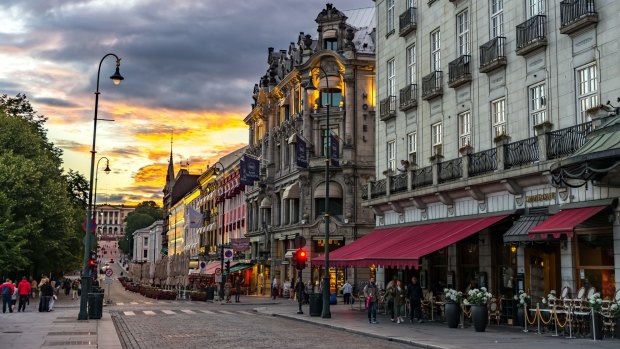
Credit: SHUTTERSTOCK
Norway's capital Oslo yields a walking extravaganza. First there's the world's largest sculpture park made by a single artist, the Vigeland Sculpture Park, which displays the work of Gustav Vigeland, then the Viking Ship Museum and the Norwegian Museum of Cultural History, which includes the Open Air Museum.
The following day we dock off the isle of Marstrand, Sweden, once the country's herring capital, now a summer retreat for water-sports-mad Swedes. Zodiacs ferry us to the island for three choices – a five-kilometre kayak through part of the Gothenburg Archipelago with views to Marstrand and its massive Carlsten fortress, a vigorous climb up to the fortress, or a walking tour through the pretty town.
Later, it's Denmark's turn. We dock at Skagen, in north Denmark, at the meeting of two seas: the Baltic and North Seas. It's hard to go past the 15-kilometre cycle tour taking us through the protected landscape on the east coast, on to the west coast and into old Skagen town with its characteristic yellow houses, once the home of local fishermen.
Copenhagen marks the end of our journey of discovery. Some of us are fitter, some fatter, thanks to the abundant food and wine, and all are better for their taste of friluftsliv.
Apparently, Norwegians read more than any other nationality and are silver medallists to Finland as the world's biggest coffee drinkers, consuming 9.9 kilograms per person, per year. Coffee and literature sound like a fine road to happiness.
FIVE MORE NORWEGIAN ACTIVE ADVENTURES
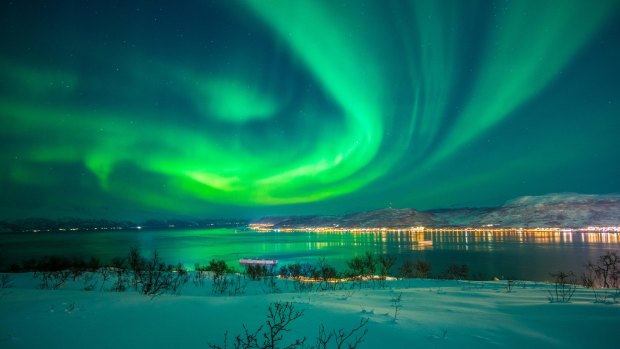
Credit: Alamy
Hunt the northern lights by dog sled pulled by Alaskan huskies to experience the tranquillity of Arctic mountains, frozen lakes and wilderness camping. Fitness required. See activetromso.no
Cycle the historic 80-kilometre Rallarvegen bike route from the mountains to the fiords along the Bergensbanen and Flamsbanen railway lines. The roads once supported the construction of the railway, which connects Oslo to Bergen. See visitnorway.com
The narrow fiords, islands and dramatic mountains of northwest Norway's Helgeland coast provide an ideal environment for sea kayaking, while fiords such as the UNESCO-listed Naeroyfiord offer quieter paddles. See visitnorway.com
Experience the culture of Europe's northernmost indigenous people, the Sami, by visiting the Sami capital, Karasjok and neighbouring Kautokeino in the Norwegian tundra. Learn about reindeer husbandry, traditional fishing, cuisine and culture. See visitnorway.com
Catch, learn to cook, and eat king crabs on a northern Norwegian Kirkenes king crab safari. Red king crabs can have leg spans of 1.8 metres and weigh up to 15 kilograms. See visitkirkenes.no
TRIP NOTES
Alison Stewart was a guest of APT
MORE
FLY
Qatar Airways flies daily from Sydney and Melbourne to Stockholm or Oslo via Doha, then Tromso with Scandinavian Airlines. See qatarairways.com flysas.com
CRUISE
APT's 15-day Majestic Norwegian Fjords small ships expedition cruise from Tromso to Copenhagen starts from $16,895 a person twin share (price based on standard suite forward), including $900 a couple air credit. Based on an August 22, 2019 departure.
See aptouring.com.au or call 1300 196 420
See also: These Norwegian islands are the most beautiful place on Earth
See also: Why Norwegians are upset over Mission Impossible's spectacular cliff stunt
Sign up for the Traveller Deals newsletter
Get exclusive travel deals delivered straight to your inbox. Sign up now.